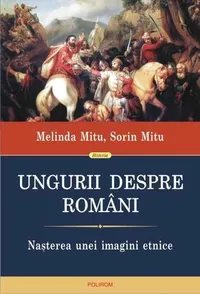
Ungurii despre români: nașterea unei imagini etnice
In the past six months I’ve become a little more curious about Romanian history.
After getting through books about the extremist movements that were present in Romania before the Communist era, Holy Legionary Youth: Fascist Activism in Interwar Romania and Anii treizeci. Extrema dreaptă românească, I wanted to read this one where we get to see how Romanians are portrayed through the eyes of our Hungarian neighbors.
As the book description mentions, the Romanian-Hungarian relationship is a mixed one.
“In the ‘official chronicle’ of Europe, as it has been written by historians over the past two centuries, Romanians and Hungarians form one of the continent’s main conflictual pairings.”
While this is one of the conflictual pairings in history, they didn’t always perceive each other like this at the same time.
If we really simplify the subject, the main thing that sparked this issue was the region called Transylvania. More specifically, who this region belongs to.
As a side-note: it seems the Hungarian historians agree that the Romanians (or their ancestors) were the first on these lands. But that means little to nothing when you’re not the one ruling that region.
Of course there is more to it, it’s about civil rights, right of ownership, political representation, religion, language, etc.
The book helps bring some perspective on how certain events changed the way one side saw the other one.
The authors go through records from back in the 15th century and even earlier, up to the revolution that took place in 1848. It presents the information in chronological order to try and provide an overall image of how these nations came to be and why there was (or still is?) a dispute about territory, way of life, religion, etc.
It’s very interesting to see details about your nation, but all accounts coming from the other side.
The Hungarians never thought of Romanians as a real threat to their nation, not until the 1840s. At that point, the tension inside Hungary and Transylvania was high because all the other nations living in these territories wanted to be recognized and given equal rights (Romanians, Germans, Slavs, and others).
Out of all the nations living inside Transylvania, Romanians were the majority and at the same time the ones that were treated the poorest along with the Slavs.
It had to do with the geopolitical situation at the time. For Hungary, Russia was the great danger from the north. The fact that Romanians were Orthodox and had a lot of influences from the east, after years and years of Ottoman occupation, made them a weak link that could be influenced by the Russians into messing with Hungarian politics from the inside.
This issue was acknowledged at the time, as all this information comes from Hungarian publications.
These problems escalated because of how Romanians were treated, as second-class citizens at best, inside a territory where they were a majority and had originally populated it. The lack of education in their own language, civil rights, and political representation made it harder for Romanians to want to be fully integrated into the Hungarian nation. This led up to the 1848 revolution in Transylvania that was happening along with the other Romanian Principalities and the whole of Europe.
It was a great read, but not an easy one. It took me a good amount of time to complete it.
Description
This description is grabbed from Google Books or GoodreadsIn the 'official chronicle' of Europe, as it has been written by historians over the past two centuries, Romanians and Hungarians form one of the continent's main conflictual pairings. Melinda and Sorin Mitu show how Romanians have been perceived by their neighbors over time, in an attempt to explain the historical events that placed Romanians and Hungarians at the forefront.
Based on hundreds of manuscripts, speeches, essays, travel journals, and press articles, the mental images and ideological representations generated by the turbulent shared past of the two peoples are described.
The result is a genuine imagological project, a 'composite portrait' of Romanians from various perspectives—those of historians, politicians, Hungarian journalists, and even ordinary Hungarians—that highlights aspects less known to the public.